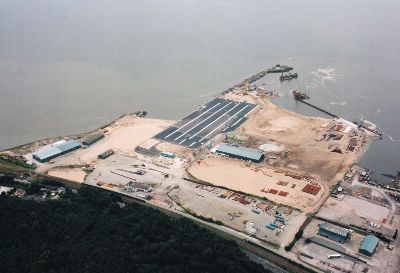It is impressive how the North Wales Port of Mostyn has adapted to change over time. It is one of the oldest commercial ports in the British Isles. Its role in British political and economic history is easily overlooked.
A Key Role
It now plays a key role in addressing one of the most critical issues of present times – climate change. It does it in a way that negates its carbon footprint and enables others to do the same.
Mostyn was apparently where Henry Bolingbroke landed in 1399 before he seized the crown from Richard II at Flint Castle. It is also said Henry Tudor landed here upon his return from exile in France to inflict defeat upon Richard III at the Battle of Bosworth Field in 1485. Both were key moments in shaping the future of British history.
Businesses need to progress to survive and thrive. The story of how the port has adapted to the ebb and flow of industrial change is well documented in the book Sea Change – History of the Port of Mostyn written by Patricia O’Toole. Who was the late wife of the current visionary Managing Director, Jim.
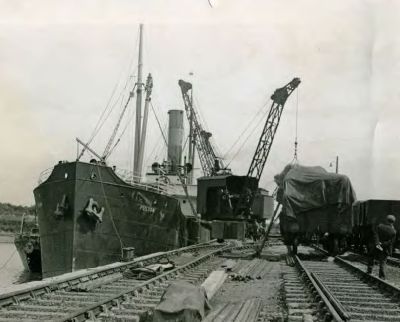
The Bessemer Process
Mostyn has a long history of handling cargo, including steel, timber and wood pulp. It also managed bulk shipments of coal, iron ore, woodchip and sulphur for the region’s heavy industries.
When the Bessemer process (1856) enabled steel to be mass-produced, Mostyn received imports of manganese ores from Spain, North Africa, Russia and South America. It then transferred them to The Darwen And Mostyn Iron Company and Brymbo Steelworks near Wrexham as part of the toughening process.
Large quantities of esparto grass were imported for the area’s paper production. Animal feedstuffs and fertilizers for the agricultural sector of North Wales, the Northwest and the Midlands were also handled at the port.
Mostyn has seen many changes and improvements over the years to accommodate larger vessels requiring deeper berths and longer quays. The years 2001 and 2002 saw the construction of a 190-metre extension to the riverside quay and a 170-metre long roll-on/roll-off berth for the shipment of cargo such as cars and trucks.
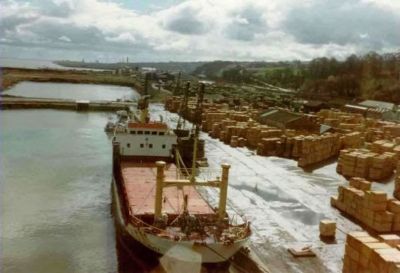
A380 Aircraft Wings
When the book Sea Change ended in 2001, it seemed like the port had a secure and settled future as part of a P&O ferry service between Mostyn and Dublin. However, in 2004, P&O announced its bombshell decision to axe the service. Leaving the Port of Mostyn uncertain about its future. In June, the port secured the business of shipping the Broughton-built Airbus A380 aircraft wings to Toulouse in France. These shipments continued until production of the A380 ended.
In 2004, Jim O’Toole, made a dramatic and visionary decision that set the port in an entirely new direction. He fully embraced the looming requirement for climate change mitigation and the need to generate low-carbon renewable energy. The port’s future, he decided, would lie in that direction. In 2004, the Port of Mostyn became the first to construct a full-scale offshore wind farm in UK territorial waters when the North Hoyle wind farm was commissioned. This pioneering approach meant Mostyn can rightly claim to be the birthplace of the UK’s offshore renewable energy sector.
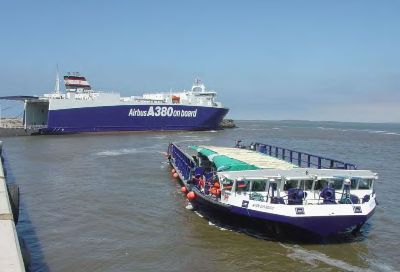
A Eureka Moment
It was a true eureka moment. Looking back, the Port of Mostyn not only moved away from activities contributing to carbon emissions, it also pioneered an entirely new UK development generating renewable offshore wind energy!
I remember returning to see friends in my former town of West Kirby in Wirral. They had looked out to the Dee Estuary and seen the natural beauty of Hilbre Island with the outline of the North Wales Coast behind it. Now, to their bewilderment, they see a background that includes a series of wind turbines in the sea!
What made this so immensely controversial is the need for renewable energy had hardly been recognised at the time.
When Al Gore, the former Vice President of the USA, made the Oscar-winning documentary An Inconvenient Truth in 2006. It received an extremely hostile reaction from sceptics who could not accept the message that climate change was a serious problem.
The Port of Mostyn, had embarked upon the Road to Damascus and had seen the light at an early stage. Since then, the port has been involved in six more offshore wind farms. 90% of its business now comes from wind turbine assembly and maintenance.
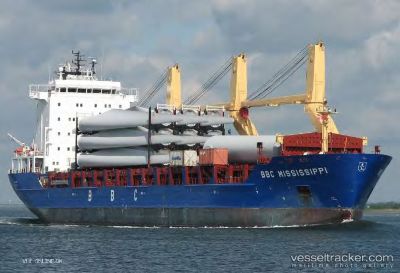
Natural Resources Wales
However, we now reach yet another exciting point in the story of the port. The vision is developing way beyond the original concept. The Port of Mostyn is preparing to lead the way, with the next generation of larger and more powerful wind turbines.
Jim O’Toole and his team have been working for two years on a project. It involves applying to Natural Resources Wales (NRW) for a marine licence to make significant improvements to enable the port to handle the much larger turbines of the future.
Plans are afoot for the construction of an additional 350 metre-long quay wall and the reclamation of 4.5 hectares of land behind it. The project is an immense one and is likely to see the employment of up to 300 people during construction.
The vision doesn’t end there. In March 2022, the Leader newspaper reported on plans for a £590 million tidal lagoon. Developed by Mostyn SeaPower Ltd, a subsidiary of the Port of Mostyn.
One year on, this project is going to plan. Although due to recent inflation, the original estimate of costs is now closer to £700 million. However, the cost of electricity has also risen in line with inflation, thus enabling the project to remain economically viable.
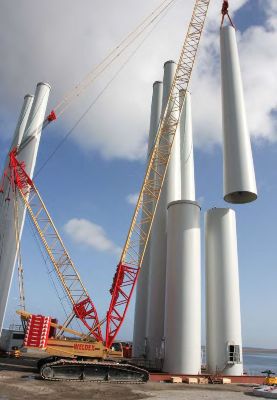
700 Tons of Steel!
Estimates suggest construction will involve 7 million tons of stone, 3 million tons of fill, 700 tons of steel and 200,000 tons of concrete. Around 450 people will be employed during the lagoon construction. Creating about 35 permanent maintenance jobs during its operational life of over 100 years.
This project will generate enough very low-carbon electricity for some 82,000 homes. It will also provide four miles of coastal flood defences for surrounding properties, the A548 Coast Road and the Holyhead to Crewe railway line along the low-lying North Wales coast between Mostyn and Point of Air.
We can, neither belittle nor dismiss the powerful objections that conservationists will raise to the wind turbine and the tidal lagoon proposals. Some will vigorously argue marine life has suffered immensely through climate change. The best thing we can do is to leave it completely alone.
Global warming is leaving our seas ‘out of sync’ and is affecting the lifecycle and breeding of species like grey seals.
Several types of kelp are also declining. The impact on zooplankton means less food for sand eels which in turn leads to a decline in birds like Arctic terns, puffins and kittiwakes. The well-being of marine ecology is at serious risk.
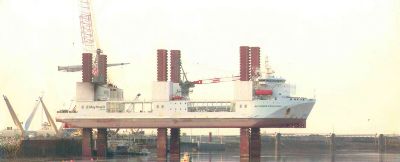
Extensive Survey Work
The Dee Estuary is immensely important from an ecological point of view. It has several designations: Special Protection Area (SPA), Special Area of Conservation (SAC) and RAMSAR site under the Convention of Wetlands of International Importance, especially for waterbird habitats.
Mostyn SeaPower Limited, is undertaking extensive survey work to identify if birds, fish and mammals may be affected by the developments. It will be seeking measures to mitigate any adverse impact upon them.
It is a catch-22 situation. Climate change is altering the environment, but we cannot address this change without further affecting the environment, albeit temporarily.
The Port of Mostyn considers itself engaged in important work to combat the effects of climate change. It will succeed in the debates that are bound to follow. The production of green, renewable energy is fundamental to addressing the issues raised by climate change. By reducing emissions locally, we help to reduce emissions globally. The production of green renewable energy is the key to protecting the environment for humanity and wildlife.
Written by Dave Healey.
